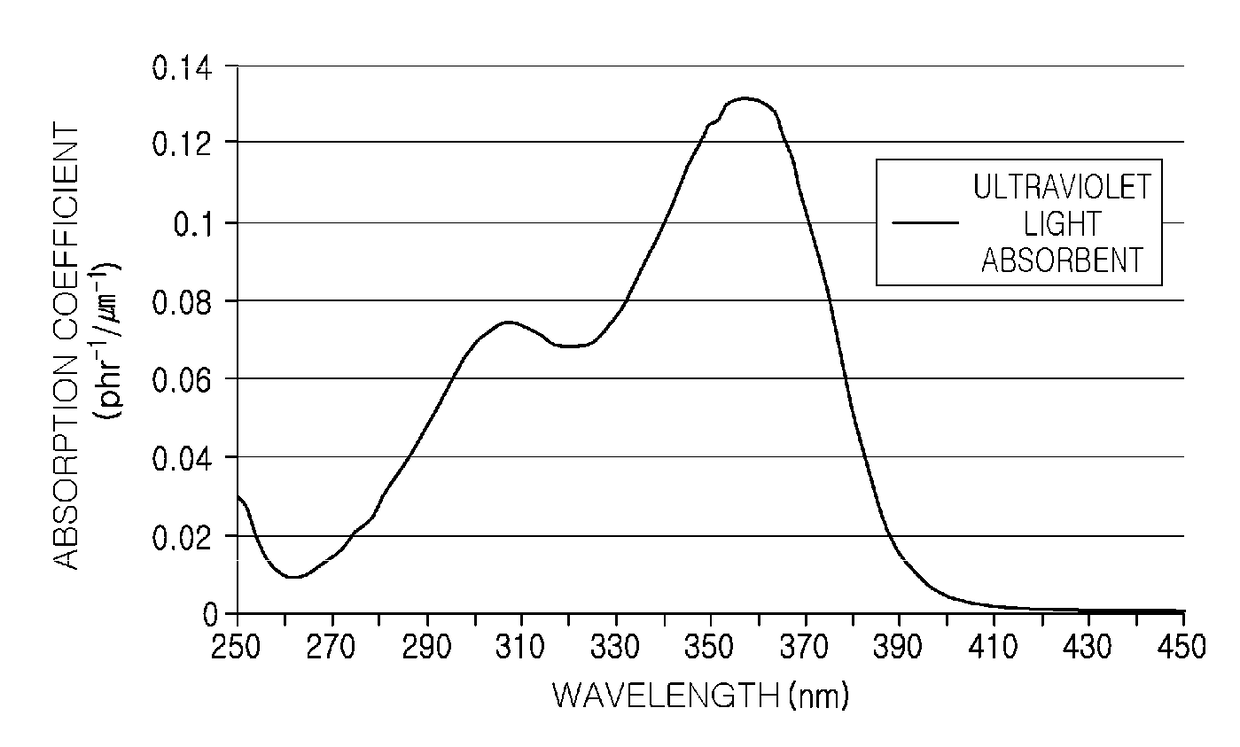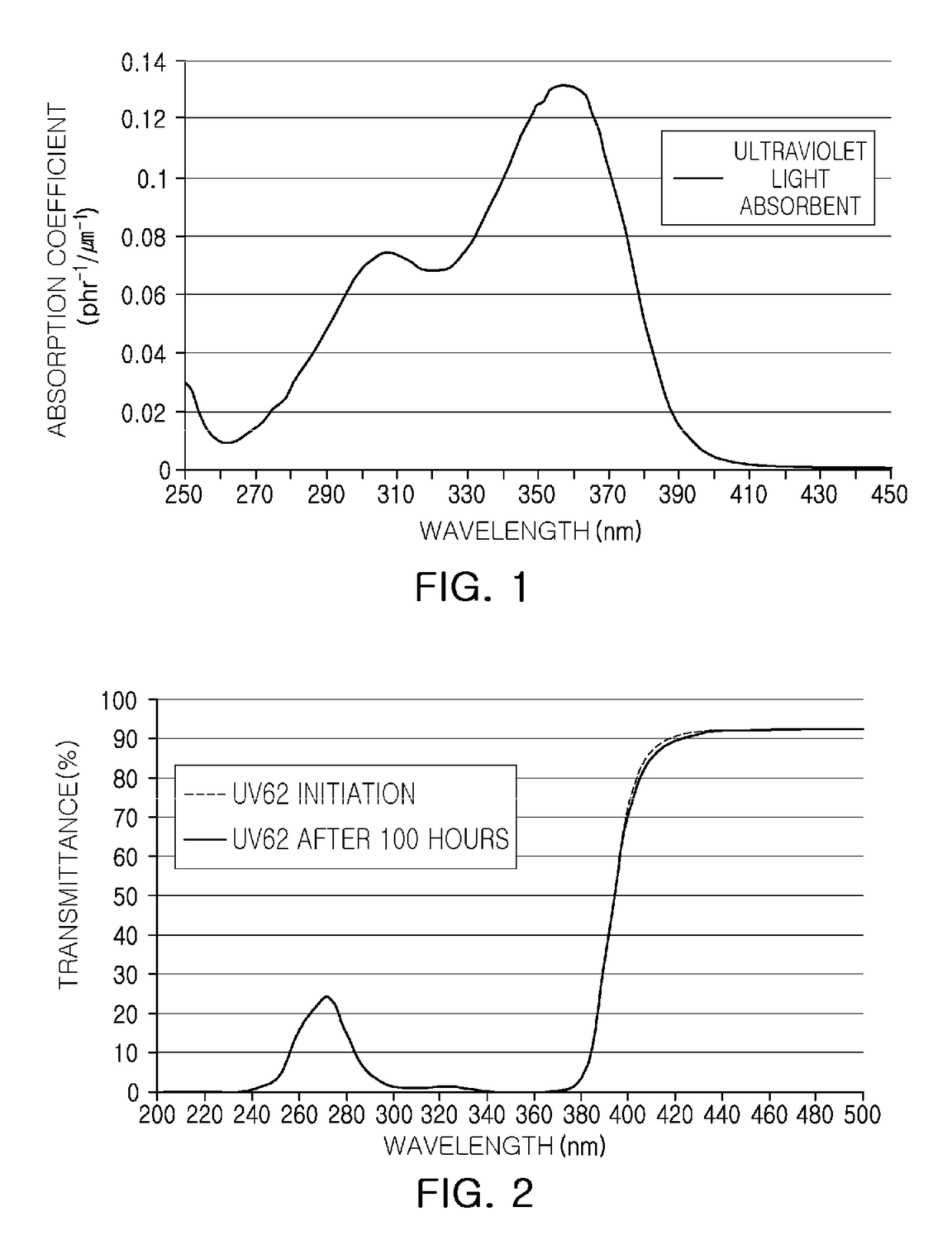Optical film exhibiting excellent blocking properties for ultraviolet light and polarizing plate including the same
a technology of ultraviolet light and ultraviolet light, applied in the direction of optical elements, polarizing elements, instruments, etc., can solve the problems of ultraviolet light absorption, deformation of polarizing plate properties, degradation of heat and humidity resistance of tac films, etc., to achieve high efficiency, reduce optical transmittance, and improve ultraviolet light absorption efficiency
- Summary
- Abstract
- Description
- Claims
- Application Information
AI Technical Summary
Benefits of technology
Problems solved by technology
Method used
Image
Examples
example 1
[0153]A raw material pellet was prepared by supplying a resin composition, in which 0.7 parts by weight of the ultraviolet light absorbent and 0.2 parts by weight of the hindered amine light stabilizer (HALS) SABOSTAB UV62 manufactured by Songwon Industrial Co., Ltd. were uniformly mixed with 100 parts by weight of poly(N-phenylmaleimide-co-methylmethacrylate-co-α-methyl-styrene-co-methacrylate) having a glass transition temperature of 120° C., to a 24φ extruder in which from a raw material hopper to an extruder was substituted with nitrogen, and melting the resin composition at 250° C. An NMR analysis result showed that the poly(N-phenylmaleimide-co-methylmethacrylate-co-α-methyl-styrene-co-methacrylate) resin had a content of N-phenylmaleimide in 5.0% by weight and α-methyl-styrene in 2.0% by weight.
[0154]The raw material pellet prepared above was dried under vacuum, melted using an extruder at 250° C., and then passed through a coat hanger-type T-die, a chromium-plated casting ro...
example 2
[0156]A raw material pellet was prepared by supplying a resin composition, in which 0.7 parts by weight of the ultraviolet light absorbent and 0.2 parts by weight of the hindered amine light stabilizer (HALS) SABOSTAB UV94 manufactured by Songwon Industrial Co., Ltd. were uniformly mixed with 100 parts by weight of poly(N-phenylmaleimide-co-methylmethacrylate-co-α-methyl-styrene-co-methacrylate) having a glass transition temperature of 120° C., to a 24φ extruder in which from a raw material hopper to an extruder was substituted with nitrogen, and melting the resin composition at 250° C. An NMR analysis result showed that the poly(N-phenylmaleimide-co-methylmethacrylate-co-α-methyl-styrene-co-methacrylate) resin had a content of N-phenylmaleimide in 5.0% by weight and α-methyl-styrene in 2.0% by weight.
[0157]The raw material pellet prepared above was dried under vacuum, melted using an extruder at 250° C., and then passed through a coat hanger-type T-die, a chromium-plated casting ro...
example 3
[0159]A raw material pellet was prepared by supplying a resin composition, in which 0.7 parts by weight of the ultraviolet light absorbent A and 0.2 parts by weight of the hindered amine light stabilizer (HALS) LA 63 manufactured by ADEKA corporation were uniformly mixed with 100 parts by weight of poly(N-phenylmaleimide-co-methylmethacrylate-co-α-methyl-styrene-co-methacrylate) having a glass transition temperature of 120° C., to a 24φ extruder in which from a raw material hopper to an extruder was substituted with nitrogen, and melting the resin composition at 250° C. An NMR analysis result showed that the poly(N-phenylmaleimide-co-methylmethacrylate-co-α-methyl-styrene-co-methacrylate) resin had a content of N-phenylmaleimide in 5.0% by weight and α-methyl-styrene in 2.0% by weight.
[0160]The raw material pellet prepared above was dried under vacuum, melted using an extruder at 250° C., and then passed through a coat hanger-type T-die, a chromium-plated casting roll, a drying roll...
PUM
| Property | Measurement | Unit |
|---|---|---|
| wavelength band | aaaaa | aaaaa |
| wavelength band | aaaaa | aaaaa |
| thermal decomposition temperature | aaaaa | aaaaa |
Abstract
Description
Claims
Application Information
 Login to View More
Login to View More - R&D
- Intellectual Property
- Life Sciences
- Materials
- Tech Scout
- Unparalleled Data Quality
- Higher Quality Content
- 60% Fewer Hallucinations
Browse by: Latest US Patents, China's latest patents, Technical Efficacy Thesaurus, Application Domain, Technology Topic, Popular Technical Reports.
© 2025 PatSnap. All rights reserved.Legal|Privacy policy|Modern Slavery Act Transparency Statement|Sitemap|About US| Contact US: help@patsnap.com



